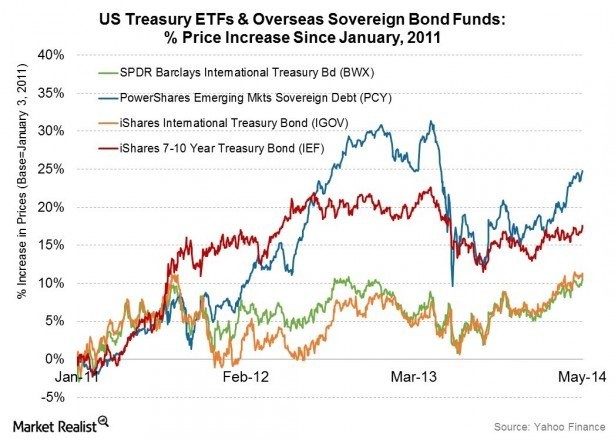Two New Emerging Market Bond ETFs Avoid Interest Rate Risk
Post on: 8 Май, 2015 No Comment

NEW YORK (TheStreet ) —An ever-expanding niche in the ETF space is emerging market debt as investors starved for yield look to unfamiliar market segments for their income needs. Investors have two new funds to consider with the Market Vectors Emerging Market Aggregate Bond ETF EMAG and the ProShares Short Term USD Emerging Markets Bond ETF EMSH.
EMAG was converted from the more narrowly focused Market Vectors LatAm Aggregate Bond ETF (LATM ). Similar to the iShares Barclays Aggregate Bond ETF (AGG ) The word aggregate in the name of the fund refers to the fact that EMAG owns both sovereign and corporate debt. As an administrative note AGG recently changed its name iShares Core Total US Bond Market ETF while keeping the same symbol and investment strategy.
Unusual compared other emerging market debt funds is that EMAG owns some bonds that are denominated in U.S. dollars and some local currency debt. The current currency mix allocates 50% to the U.S. dollar and 50% in foreign currencies. Many emerging market bonds are issued in U.S. dollars to make them more attractive to investors.
The country allocation still tilts to Latin America with almost 10% each to Brazil and Mexico and smaller allocations to Colombia, Venezuela and Peru for a total of 29%. China receives a 7% weighting, Poland 5% with the remaining countries having much smaller weightings.
Sovereign debt comprises 61% of the fund. Debt from financial companies makes up 11% of the fund and 9% in energy companies. The quality breakdown of EMAG favors investment grade at 67%, 19% is non-investment grade with the remainder being unrated debt.
EMAG has an effective duration of just over five years which should insulate fund holders somewhat if and when global interest rates start to rise. It is important to note that the fund’s average maturity is closer to 7.5 years. The significance here is that in general terms, when rates go up duration tends to extend because fewer bonds get called early which could increase the funda’s sensitivity to rising rates.
EMSH from ProShares takes less interest rate risk because its duration is 2.19 years and its average maturity is just 2.46 years.
The country weightings between the two are fairly similar with 10% in Russia, roughly 9% each in Brazil, Mexico, Turkey, the Ukraine and Indonesia. The country weight is capped at 10%.
The Ukraine has of course been in the news lately as protesters have taken to the streets because President Viktor Yanukovych has not signed an agreement with the European Union. While it is a little early to be worried about the viability of Ukrainian debt, a deterioration of the situation could impact EMSH’s price.
Unlike EMAG which includes corporate bonds, EMSH only owns sovereign and quasi-sovereign debt. Quasi-sovereign debt is issued by agencies with government backing as opposed to being directly government issued.
While both funds are too new for reliable dividend information both funds will have higher yield than Treasury ETF with similar maturities but there is a threat to these funds when the Federal Reserve finally begins to taper its asset purchases and then eventually begins to increase interest rates.
Last spring when the Fed began to hint about reducing asset purchase the iShares JP Morgan USD Emerging Market Bond ETF (EMB ) fell 12% in just over a month which is a huge move for a bond fund. Emerging market debt is viewed as being vulnerable to tapering or tightening because when rates go up here there is less need for investors to own emerging market debt if they can get satisfactory yields with domestic debt.
EMB has a longer average maturity than EMAG or EMSH so they would be unlikely to drop as much as EMB if rates go up but the size of the drops could catch investors off guard.
At the time of publication the author held no positions in any of the stocks mentioned.
This article is commentary by an independent contributor, separate from TheStreet’s regular news coverage.














